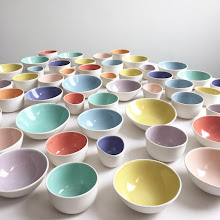
Imagery has been a part of ceramics for centuries. There are many ways of applying an image to a ceramic surface, and “transferware” is a particular style of decorative ceramics.



Transferware is created by transferring a printed image onto the surface either under or over a glaze. This transfer technique, the predecessor to a more modern technique I use on gleena, was developed in England in the mid-18th century, particularly around the Staffordshire region.
The process starts with an engraved copper plate similar to those used for making paper engravings. The plate is used to print the pattern on tissue paper, then the tissue paper transfers the wet ink to the ceramic surface. The ceramic is then fired in a low temperature kiln to fix the pattern. This can be done over or under the glaze. The process produces fine lines similar to the engraved prints in old books. Before transfer printing ceramics were hand painted, a laborious and costly process. You can find more information, and sample patterns, on the Transferware Collector's Club website.
I love the backs of the plates, shown below with the mark of the maker, just as much as the fronts, if not more. This is where graphic design has met ceramics over the centuries.









